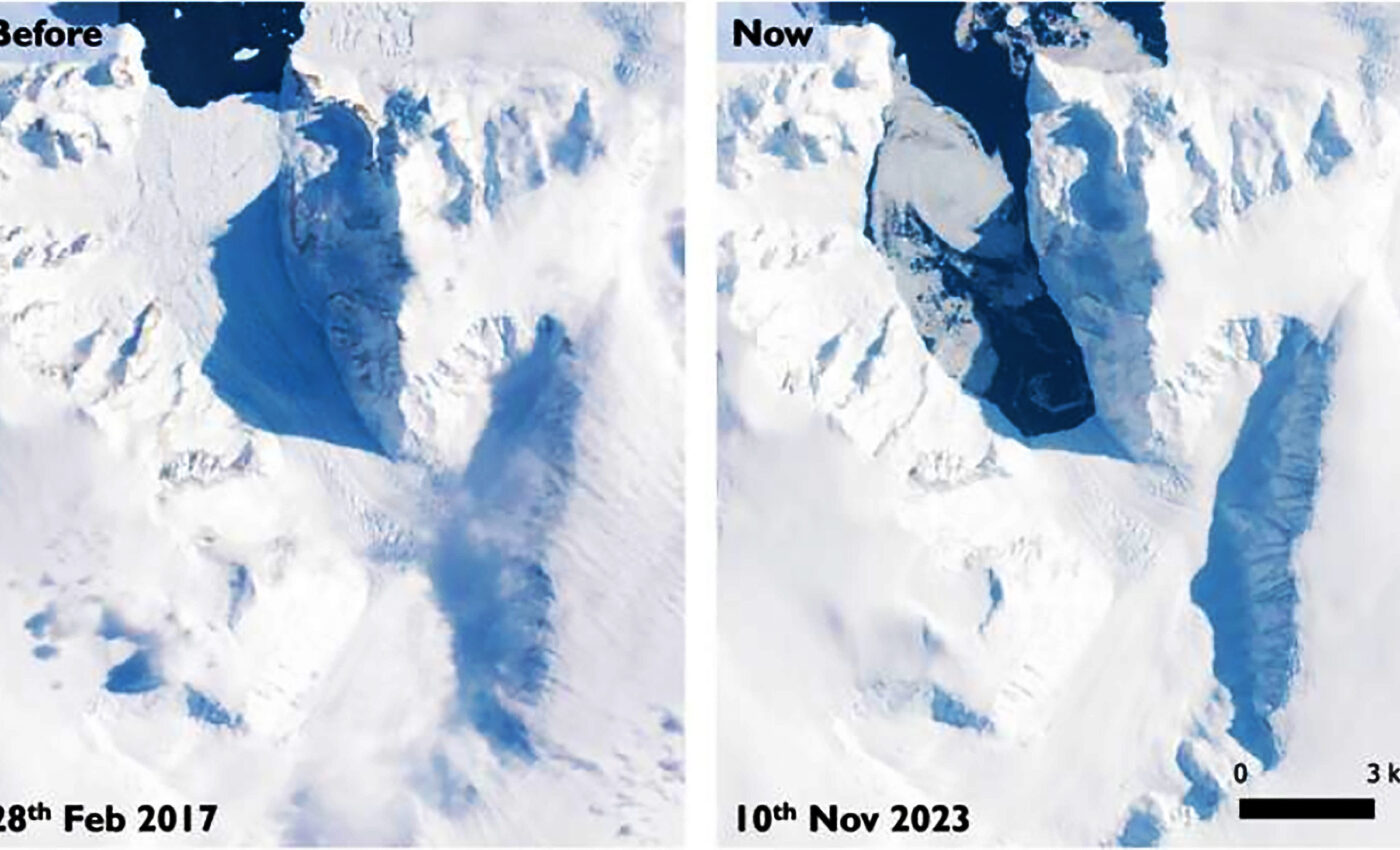
Cadman Glacier is losing 2.1 billion tons of ice melting into the ocean each year
Scientists are raising alarms about the rapid and unpredictable behavior of Antarctic glaciers, with a focus on the Cadman Glacier, which has exhibited alarming changes in recent years.
A group of scientists headed by Benjamin Wallis, a glaciologist from the University of Leeds, released a report that underscores the significance of their findings for comprehending the behavior of glaciers and the potential impact on worldwide sea levels.
Studying the Cadman Glacier melt
The team utilized satellite data to monitor the Cadman Glacier, which flows into Beascochea Bay on the west Antarctic peninsula. Between November 2018 and May 2021, they observed an alarming eight-kilometer retreat of the glacier.
This was precipitated by the collapse of the ice shelf at the glacier’s end, which had previously acted as a buttress, slowing the glacier’s seaward movement. The loss of this ice shelf, attributed to warmer ocean waters, led to a dramatic acceleration in the glacier’s flow, doubling its speed and increasing ice discharge through iceberg calving.
State of the Cadman Glacier
Benjamin Wallis expressed his team’s surprise at the rapid transition of the Cadman Glacier from a state of apparent stability to one of significant deterioration and ice loss. He noted the unique response of this glacier compared to its neighbors, underscoring the complexity of predicting climate change impacts in polar regions.
Wallis said: “We were surprised to see the speed at which Cadman went from being an apparently stable glacier to one where we see sudden deterioration and significant ice loss.
“What was also curious was that the neighboring glaciers on this part of the west Antarctic Peninsula did not react in the same way, which may hold important lessons for the way we can better project how climate change will continue to affect this important and sensitive polar region.
“Our study brought together data from three decades, nine different satellite missions, and in-situ oceanographic measurements to understand the changes happening in Antarctica. This demonstrates how important it is to have long term monitoring of the Earth’s polar regions with a range of sensors which all tell us a different piece of the story.”
How the study was conducted
Their research, integrating data from multiple satellite missions and oceanographic measurements, stresses the importance of long-term, diverse monitoring of Earth’s polar regions.
Currently, the Cadman Glacier is in a state of “substantial dynamic imbalance.” The glacier is thinning at a rate of about 20 meters per year, equivalent to the height of a five-story building, and is shedding approximately 2.16 billion tons of ice annually into the ocean.
This rapid change was triggered by unusually high ocean temperatures around the west Antarctic peninsula in early 2018/19, believed to have been impacting the glacier since the early 2000s or possibly even the 1970s.
The warmer ocean waters, present deep in the water column, may have reached and melted the ice shelf from the bottom up. In 2018/19, this melting was so extensive that the ice shelf broke free from its grounding zone, allowing the glacier to drain more ice into the sea.
Unanswered questions remain
The research team is still investigating why the Cadman Glacier collapsed while neighboring glaciers like Funk and Lever remained relatively stable. They speculate that subsea rock structures, acting as barriers, might be deflecting warmer water away from these glaciers. However, increasing ocean temperatures could eventually overcome these natural defenses.
Professor Michael Meredith from the British Antarctic Survey, a co-author of the study, emphasized the rapid warming of the ocean around Antarctica and its threat to glaciers and ice sheets. He highlighted the need for comprehensive ocean monitoring, especially near hard-to-reach glaciers.
Meredith said, “We have known for some time that the ocean around Antarctica is heating up rapidly, and that this poses a significant threat to glaciers and the ice sheet, with consequences for sea level rise globally.
“What this new research shows is that apparently stable glaciers can switch very rapidly, becoming unstable almost without warning, and then thinning and retreating very strongly. This emphasizes the need for a comprehensive ocean observing network around Antarctica, especially in regions close to glaciers that are especially hard to make measurements.”
Implications of Cadman Glacier melt
The researchers describe the Cadman Glacier’s transformation as a “glaciological tipping point,” a concept where a stable system can become unstable due to a change in environmental conditions. In this case, the arrival of warm ocean water caused the glacier’s ice shelf to unground, leading to a 28% increase in ice discharge in just 13 months.
This study suggests that other glaciers on the Antarctic Peninsula might also be vulnerable to rapid changes due to subsea geology and environmental factors. These findings underscore the urgency of understanding and monitoring glacial dynamics to better predict and mitigate the impacts of climate change on global sea levels.
The full study was published in the journal Nature.
—
Like what you read? Subscribe to our newsletter for engaging articles, exclusive content, and the latest updates.
—
Check us out on EarthSnap, a free app brought to you by Eric Ralls and Earth.com.













